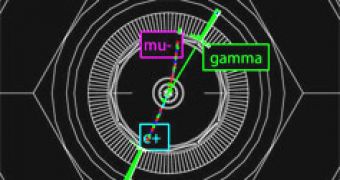The Holy Bible describes an event in which Jesus Christ turns water into wine. Personally I would really like to see that one. However it has nothing to do with reality, as we all know water does not spontaneously turn into wine, or vice versa. This principle should also apply to all the elementary particles predicted in the Standard Model. Electrons are part of the leptons family, as are muons and taus and must therefore conserve their so-called 'flavor'.
Meaning that taus particles also decay into neutrinos, never into a particle such as electron neutrinos or muon neutrinos, and even if a lepton decay produced another lepton, it would need to be instantaneously followed by its anti-particle. Scientists from the Stanford Linear Accelerator Center are currently developing an experiment to find evidence for leptons that might break this rule, thus paving the way for another theory of quantum physics.
Though the Standard Model which describes all the elementary particles is pretty straight forward and well understood, it still does not explain a series of phenomena observed in the quantum physics, which leaves room for many physicists to believe that the theory is incomplete. Analysis made on the basic principles of the Standard Model have been made previously by Soeren Prell from the Iowa State University and revealed that most of the elementary particles checked, back up the Standard Model theory.
Nevertheless there are some discrepancies, thus the violation of lepton flavor process is only one of the tasks to discover flaws in the Standard Model.
The team from BaBar is mostly concentrating on the collision of hadrons, B mesons to be more exact. These particles can be produced in particle colliders, through the interaction of electrons and their anti-particle. This interaction generally produces extremely high numbers of tau and anti-tau particles. The BaBar experiment has as primary objective the study of the matter and anti-matter interaction, that mainly focuses on the CP-violation of the B-meson (B) and its anti-particle (B-bar).
So far during the 440 million tau/anti-tau collision events, scientists haven't found any evidence of flavor violation, nevertheless they managed to gather an enormous amount of data without the adding of any supplementary equipment.
The tau lepton led to special interest to the BaBar team, since it is the heaviest lepton known so far, having a mass 3.500 times greater than that of the lightest lepton, the electron. A particle cannot gain any mass through a collision, but it can decay into other lighter particles. Electrons cannot decay into any other lepton since it is not heavy enough, however muons could possibly decay into an electron, though the actual process has not ever been observed. The same process could be true for the taus, which might decay into any of the known leptons, thus making it an excellent candidate to examine.
The BaBar experiment is scheduled to end in 2008 and the scientists hope that they will have been able to present the preliminary results of their study by the next summer and publish them in the spring of 2009.

 14 DAY TRIAL //
14 DAY TRIAL //